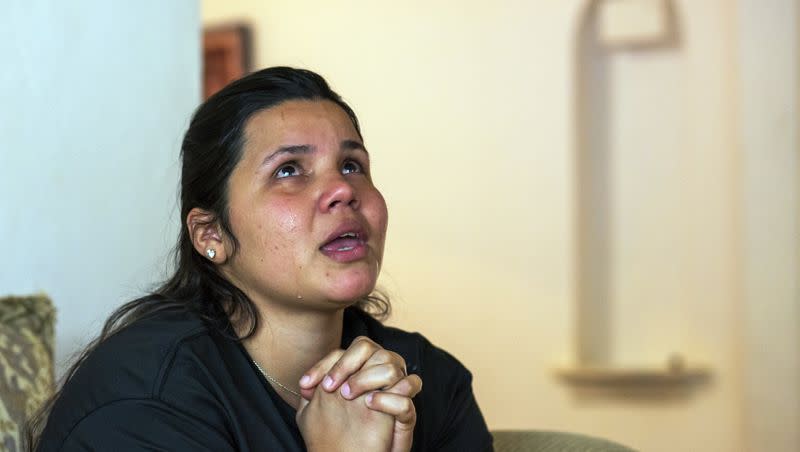Opinion: The reason behind the Venezuelan flight to U.S. safety

- Oops!Something went wrong.Please try again later.
If you want to understand the border crisis and the press of Venezuelan refugees in New York City and elsewhere, you need to know about the Helicoide.
That’s an architectural landmark in Caracas, the capital of Venezuela. In the 1950s, it was designed to be the world’s first drive-through shopping mall. But it never was finished — a victim of difficult economic and political times.
Today, it is a massive torture chamber for political opponents of President Nicolas Maduro. At least that’s how the BBC described it after interviewing former prisoners and some former guards who were willing to talk anonymously.
“Every day I would come across people covered in blood, others tied up, some even unconscious,” a former prisoner, Rosmit Mantilla, is quoted saying on a BBC slideshow that recreates the horrors alleged to be happening in the prison. Many details of that report are too gruesome to share here.
The report says a share of the prisoners there were simply rounded up from crowds near anti-government protests, even though some of them were just in the wrong place at the wrong time.
If you lived in a nation where this was happening, would you look for a way out, even if it meant walking across a continent to get to the United States?
Too often, the nation’s immigration crisis becomes a battle of shallow stereotypes in Washington. That’s true for every facet of the debate.
The practice of rounding up asylum-seekers and either busing or flying them to self-proclaimed sanctuary cities or states with Democratic majorities cannot be justified as anything more or less than a political stunt. Texas Gov. Greg Abbott and Florida Gov. Ron DeSantis aren’t looking for any sort of meaningful answers to immigration reform by doing this.
However, if the political left were serious about solving this issue, it would admit that it isn’t fair for border states to bear the full brunt of this crisis, either. Immigration is a federal issue, and a system should be in place for all 50 states to share in the burden in a planned and organized way.
Utah Gov. Spencer Cox was right this week to say every state is a border state. In a letter signed by him and 24 other Republican governors, Cox asked for the administration to provide the details of where people admitted over the border are being relocated. That would allow for some orderly planning.
Of course, that would take some hard work in Congress, and it could jeopardize the fundraising that feeds off the kinds of stereotypes that ignore places like the Helicoide in Caracas.
Maybe you’re thinking we should just close the southern border completely to asylum-seekers. That’s your right, but you probably also haven’t read reports about how the worldwide migration crisis, fueled mainly by the need to escape violence and find safety and economic freedom, is affecting nearly every continent.
Earlier this week, the Catholic Church marked the 109th World Migrant and Refugee Day. The reports around the globe were sobering. According to Euronews and The Associated Press, more than 132,000 people have landed in Italy by crossing the Mediterranean so far this year, an increase from about 70,000 a year ago. More than 27,000 have died trying to do the same over the last nine years.
Thousands of Syrians have flooded Lebanon, trying to escape war. Lebanese officials are warning that the refugees will upset that nation’s demographic balance.
During recent trips to Sweden, I have seen firsthand how anger at immigration made a new anti-immigration party the nation’s second-largest political force.
Meanwhile, the U.S. border patrol reports that it arrested 181,059 people along the Southwest border with Mexico in August. That was actually a reduction from more than 220,000 in December.
It’s hard to say whether President Joe Biden’s recent decision to grant temporary protected status to almost 500,000 Venezuelans will affect those numbers as word trickles down. The move allows those asylum-seekers to work and live in this country, at least temporarily, without fear of deportation. But the order also does not cover anyone who came after July 31 of this year.
In honor of the Catholic Church’s World Migrant and Refugee Day, Pope Francis said migration should always be a choice, not something forced on people because of war, political oppression, poverty or climate change.
While that is a lofty ideal, it ought to be obvious that those who are willing to endure almost anything to escape the abuses of their home countries — abuses like those at the Helicoide — deserve better than to be treated as pawns in a left-right political game in this country.
The International Organization for Migration reports that 686 migrants either died or disappeared near the U.S.-Mexico border last year. The organization said that makes the border the world’s deadliest overland migration route.
Certainly, no nation should be expected to open its borders to all comers. But Americans ought to demand that Congress finally do the hard work of deciding, in a bipartisan way, on an orderly, humane and compassionate plan to deal with this problem — one that involves actual human beings in distress — as a nation.

